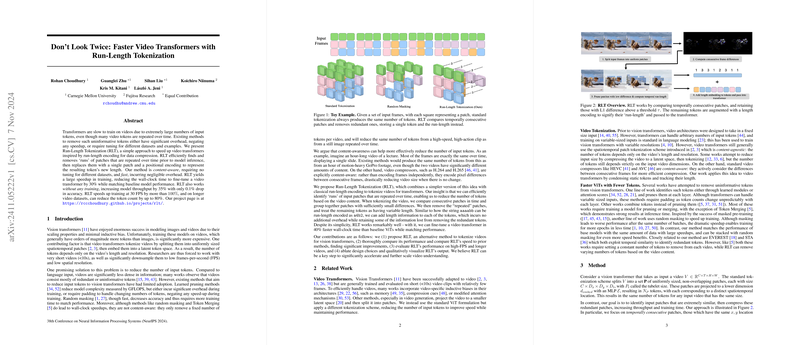Essay on "Don't Look Twice: Faster Video Transformers with Run-Length Tokenization"
The paper "Don't Look Twice: Faster Video Transformers with Run-Length Tokenization" introduces a novel tokenization strategy, Run-Length Tokenization (RLT), aimed at improving the efficiency of video transformers by reducing the number of tokens processed. This approach leverages the inherent redundancy in video data, where many input tokens are repeated over time due to static backgrounds or minimal changes across frames. The authors' primary contribution lies in the development of RLT—a tokenization method inspired by classic run-length encoding, widely used in data compression.
Key Contributions and Methodology
The research identifies a critical inefficiency in existing video transformers: the excessive computational cost incurred by the large volume of input tokens. Traditional video tokenization techniques do not differentiate between informative and redundant tokens, leading to suboptimal processing. RLT addresses this by detecting runs of repeated video patches prior to model inference and compressing them into a single token with an associated positional encoding that indicates the length of the run.
RLT stands out due to its content-aware nature, eliminating the need for dataset-specific tuning, which is a common drawback in many token reduction strategies. The method involves a simple comparison between temporally consecutive patches, retains only those patches that show sufficient change determined by a threshold τ, and encodes the length of continuous patches into a learnable positional encoding.
Experimental Evaluation
The empirical results provided in the paper demonstrate RLT's efficacy across multiple metrics. Key numerical results include a reduction of up to 80% in token numbers on longer video datasets, and a 40% reduction in the wall-clock time required to fine-tune video transformers, all while maintaining baseline performance metrics. Additionally, in scenarios demanding high throughput, RLT enhances model efficiency by up to 35% with a minor 0.1% drop in accuracy, illustrating its utility as an inference-time strategy too.
Implications and Future Directions
The introduction of RLT has potential implications for both the practical deployment of video transformers and theoretical advances in efficient deep learning algorithms. Practically, it provides a scalable and hardware-optimized solution that leverages existing GPU capabilities to accelerate video model training and deployment, making video processing more feasible in resource-constrained environments.
Theoretically, RLT opens new avenues for further exploration in dynamic input handling in transformers and efficient model training. The reduction in required computational power without sacrificing model accuracy highlights the potential for incorporating content-aware mechanisms more broadly in machine learning model design.
Future research could explore adaptations of RLT to other domains where data exhibits temporal or spatial redundancy, such as in certain sensor data streams or in optimizing data pipelines for large-scale cloud processing. Additionally, extending this approach to models that handle dense vision tasks could further establish the versatility of content-aware token reduction strategies.
In conclusion, "Don't Look Twice: Faster Video Transformers with Run-Length Tokenization" provides a significant step forward in the efficient processing of video data, balancing the high computational demands of transformer architectures with a reduction in processing redundancy. This work not only contributes to the existing body of research in computer vision but also sets a precedent for future developments aimed at optimizing deep learning workflows in video analysis and beyond.
